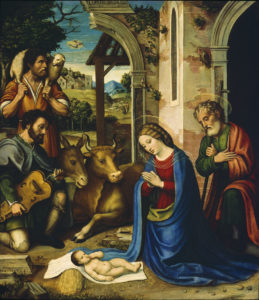Francesco Granacci’s Rest on the Flight into Egypt is an excellent example of the High Renaissance style.
Tag Archives: hurdy gurdy
The Adoration of the Shepherds
Oil on canvas
Pier Francesco Sacchi
Lombardian, c. 1485–1528
Click on the links throughout the article to view additional artists’ works and reference material.
The Adoration of the Shepherds by Pier Francesco Sacchi, in the Museum & Gallery Collection, can best be understood when one is familiar with the historical context in which the work was composed and is knowledgeable about various aspects of the composition itself.
This interesting work was composed during the Renaissance—a “rebirth” of individualism, natural science, and classical education during the fifteenth and sixteenth centuries, which ended the medieval era. Renaissance art reflects this “rebirth” which finally reached its zenith in the early 1490s centering on three central figures: da Vinci, Michelangelo, and Raphael. This apex lasted about 35 years up until Rome became a Papal State in 1527.
High Renaissance painter Pier Francesco Sacchi was from a Lombard (northern Italian) village called Pavia as indicated by his signature on several of his works. Later, he moved slightly south to the coastal city of Genoa where he apprenticed under Pantaleo Berengerio and became a member of the guild of painters in 1520. The few paintings that can be credited to him are all religious subjects.
Sacchi’s The Adoration of the Shepherd, painted in quattrocento-style (meaning a style in the 1400s, which transitioned between the medieval period and the Renaissance), was originally oil painted on a wooden panel. However, this work is one of two paintings in M&G’s collection that was transferred from its original wood panel to canvas due to decay.
Old Master painters followed a centuries-old, church tradition of painting specific symbols and attributes along with individual saints for the illiterate masses to identify visually the people and related life stories. This use of symbolism is prevalent in Sacchi’s work.
For example, the classical ruins as the backdrop for the scene are not a stable for animals. Rather, they reference Antiquity, and the broken arch represents both a bankrupt past and the necessity of the new covenant with Christ. The goldfinch, said to have eaten thorns, foreshadows Christ’s crucifixion; and the lamb the shepherd holds signifies that Christ, the Lamb of God, will offer up Himself as a living sacrifice for mankind. The worn out knees of the man holding a Renaissance instrument (called a hurdy-gurdy) represent a life of kneeling in prayer. The bundle of wheat used for Christ’s headrest prefigures His reference to Himself as the Bread of Life. Christ lying on the ground and the sparrow, considered the lowliest of birds, references Christ’s humility in coming to earth; and, finally, the tree full of leaves in the background symbolizes life, and the bare branches symbolize death.
In order to “read” a work of art, understanding the historical context in which the work was composed and the various aspects of the composition itself are necessary. M&G’s The Adoration of the Shepherds by Pier Francesco Sacchi affords the perfect opportunity for deeper knowledge about historical culture in light of Scripture.
Heather Osborne, Former M&G Graduate Assistant
Published in 2015
